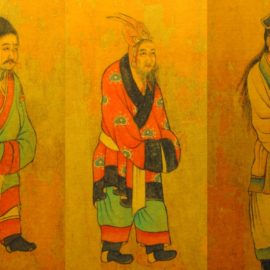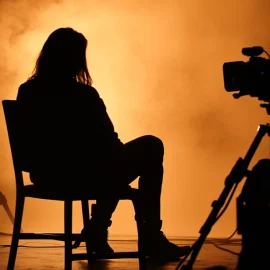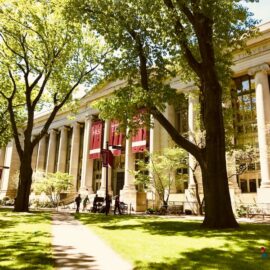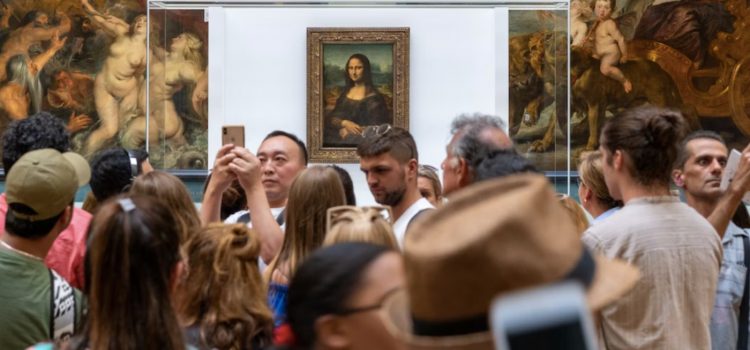
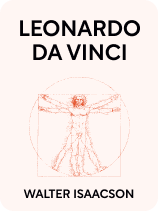
This article is an excerpt from the Shortform book guide to "Leonardo da Vinci" by Walter Isaacson. Shortform has the world's best summaries and analyses of books you should be reading.
Like this article? Sign up for a free trial here.
What are Leonardo da Vinci’s most famous paintings? Why do people still admire these paintings?
Leonardo da Vinci has a small number of authenticated paintings, but all of them are well known to the world. The three most famous are “Vitruvian Man,” “Mona Lisa,” and “The Last Supper.”
Let’s dive deeper into Leonardo da Vinci’s most famous paintings that are highlighted in his biography by Walter Isaacson.
“Vitruvian Man”
According to Isaacson, one of Leonardo da Vinci’s most famous paintings is “Vitruvian Man.” It was the result of his explorations of mathematics and philosophy and his collaboration with architects Francesco de Giorgio and Giacomo Andrea.
In 1490, Leonardo and Francesco traveled together to Pavia to consult on the design of a church. During the trip, they studied a copy of a classical treatise on architecture written by Marcus Vitruvius Pollio in the first century BCE. On their return, both of them plus Giacomo became engrossed in drawing a Vitruvian man, sharing their sketches and conversations on its deeper meaning.
Isaacson explains that the Vitruvian Man was a metaphor for the relationship between man and the cosmos. Vitruvius argued that the design for a temple should follow the proportions of a “well-shaped” man. He gave specific measurements for that well-shaped man and explained how to draw him inside a circle and a square to use as a foundation for the temple’s design.
Vitruvius’s metaphor became popular during the Renaissance because it resonated with humanist ideals. Isaacson explains that the metaphor celebrated the place of individuals in the universe as worthy of straddling the immediacy of the earth and the timelessness of the cosmos.
Of all the drawings he and his friends made, Isaacson argues that Leonardo’s “Vitruvian Man” became the definitive one thanks to his scientific and artistic commitment:
- While the other two produced sketches, he planned the drawing over several sketches and produced a confident final illustration.
- He drew the details of the man’s body, face, and hair with delicate traces, making his subject a metaphor for the human and the divine.
- He followed Vitruvius’s instructions for the placement of the man inside the circle and the square precisely, but he made adjustments to the measurements of the man. Isaacson explains that those adjustments came from his studies of anatomy and his willingness to challenge received knowledge.
“Mona Lisa”
“Mona Lisa” is one of Leonardo da Vinci’s most iconic paintings, even being one of the most famous paintings of all time. Isaacson reports that Leonardo began working on this masterpiece in 1503 and continued perfecting it until his death, putting into practice his knowledge of optics, the human body and psyche, textures, and nature. (Shortform note: You can see the painting in high resolution here.) Francesco del Giocondo, an up-and-coming silk merchant, commissioned Leonardo to paint his wife, Lisa del Giocondo. Possibly, Leonardo agreed to paint her because she wasn’t a noblewoman, and he wouldn’t have to worry about traditional rules for portraits.
How Emotions Work
The central element of the painting, Mona Lisa’s smile, is a product of Leonardo’s knowledge of optics, anatomy, and human emotion.
Isaacson reports that Leonardo had been dissecting and drawing human mouths, tracing each layer of muscle and thread of nerve. He then figured out which muscles and nerves created a smile, a purse of the lips, or any other movement of the mouth. In his notebooks, alongside different drawings of dissected mouths, there is a drawing of a smile that looks a lot like Lisa’s.
Besides in-depth knowledge of anatomy, Leonardo used optics to create Mona Lisa’s cryptic smile. Isaacson explains that Leonardo knew that the retina catches the light differently at different points of its surface, which makes the eye see things more or less clearly depending on the angle it uses. When you stare at something directly, you see it in more detail; when you look at it from the corner of your eye, you see the surrounding shadows.
Knowing this, Leonardo delineated her mouth clearly and used shadows to hint at a smile. Isaacson explains that, when you look at her mouth, you see the details but no smile; when you look anywhere else in the painting, you notice the shadows around her mouth and it seems like she’s smiling. Look back at her mouth and you lose her smile.
“The Last Supper”
“The Last Supper” is another one of Leonardo da Vinci’s most famous paintings to know. Between 1495 and 1498, Leonardo painted “The Last Supper” for Duke Ludovico—a commission that tested the duke’s patience but showcased Leonardo’s masterful application of narrative, symbology, and optics. Isaacson reports that the duke was setting up his family’s mausoleum in the Santa Maria delle Grazie monastery and he asked Leonardo to paint one of the walls of the monastery’s dining room. (Shortform note: You can see “The Last Supper” here in high definition.)
Leonardo’s creation process was haphazard, which made the monastery’s prior (or leader) and the duke uneasy. Isaacson explains that, some days, Leonardo would spend hours painting, not stopping to eat, and people would even gather around him to watch him work. On other days, he would spend hours simply looking at his work in progress, or arrive, paint a single stroke, and leave. The prior complained about his erratic progress to the duke, and Leonardo explained that working slowly allowed him to perfect his ideas. He also warned that he would use the monastery’s prior as a model for Judas Iscariot if the man didn’t stop badgering him.
The duke’s patience ran thin when his wife died. She was placed in the mausoleum, so he went to the monastery and ate dinner there every week. Isaacson says that to speed Leonardo up, Ludovico had him sign a contract clearly stipulating the deadline. But the duke’s patience was finally rewarded with a work of art that encapsulates much of Leonardo’s genius through three key characteristics that Isaacson identifies.

———End of Preview———
Like what you just read? Read the rest of the world's best book summary and analysis of Walter Isaacson's "Leonardo da Vinci" at Shortform.
Here's what you'll find in our full Leonardo da Vinci summary:
- A detailed look into the life, accomplishments, and struggles of Leonardo da Vinci
- Lessons from his life and work that you can apply to your own life
- What set Leonardo apart from other artists at the time


